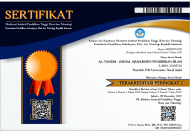Abidin, M. Z., Sabirin, M., & Taufik, M. (2022). The Dynamics of Thought and Policy of Classification of Sciences in Indonesian Islamic Religious Colleges. Khazanah: Jurnal Studi Islam dan Humaniora, 20(2), 207. https://doi.org/10.18592/khazanah.v20i2.4765
Achruh, A., & Sukirman, S. (2024). An Analysis of Indonesian Islamic Higher Education Institutions in the Era of Globalization. International Journal of Learning, Teaching and Educational Research, 23(9), 78-102. https://doi.org/10.26803/ijlter.23.9.5
Alamin, T., Mujib, A., Sulaeman, M., & Nasution, A. (2024). Reception of the Integration of Islam and Science: A Case Study at Islamic Institute of Kediri. Tribakti: Jurnal Pemikiran Keislaman, 35(1), 57-78. https://doi.org/10.33367/tribakti.v35i1.5015
Bashori, B., & Lailisna, N. N. (2023). Navigating Institutional Change: Policy Direction and Commitment to Accessibility Services in Islamic Higher Education After Transformation. Edukasi Islami: Jurnal Pendidikan Islam, 12(04), 539-556.
Blankesteijn, M., Bossink, B., & van der Sijde, P. (2021). Science-Based Entrepreneurship Education as a Means for University-Industry Technology Transfer. International Entrepreneurship and Management Journal, 17(2), 779-808. https://doi.org/10.1007/s11365-019-00623-3
Bryson, J. M., & Seo, D. (2024). Understanding Goal Formation in Strategic Public Management: A Proposed Theoretical Framework. Public Management Review, 26(2), 539-564. https://doi.org/10.1080/14719037.2022.2103173
Bunyamin, A. (2021). Management of Change in the Scientific Integration Spectrum (Study of Transferring the Status of IAIN to UIN Alauddin Makassar). International Journal of Innovative Science and Research Technology, 6(5), 785-795.
Carayannis, E. G., & Campbell, D. F. J. (2021). Democracy of Climate and Climate for Democracy: The Evolution of Quadruple and Quintuple Helix Innovation Systems. Journal of the Knowledge Economy, 12(4), 2050-2082. https://doi.org/10.1007/s13132-021-00778-x
Carayannis, E. G., Campbell, D. F. J., & Grigoroudis, E. (2022). Helix Trilogy: The Triple, Quadruple, and Quintuple Innovation Helices from a Theory, Policy, and Practice Set of Perspectives. Journal of the Knowledge Economy, 13(3), 2272-2301. https://doi.org/10.1007/s13132-021-00813-x
Chaudhry, S., & Bhattacharya, A. (2024). Student Psychological Well-Being in Higher Education: The Role of Internal Team Environment, Institutional, Friends and Family Support and Academic Engagement. Plos One, 19(1), e0297508. https://doi.org/10.1371/journal.pone.0297508
Firdaus, A., Muchtar, A., & Mikail, K. (2023). Assessing the Quality of Islamic Education and Challenges for UIN Raden Fatah Palembang in Achieving World-Class University Status. AL-ISHLAH: Jurnal Pendidikan, 15(4), 6838-6846.
Hakeem, M. M., Goi, H. C., Frendy, & Ito, H. (2023). Regional Sustainable Development Using a Quadruple Helix Approach in Japan. Regional Studies, Regional Science, 10(1), 119-138. https://doi.org/10.1080/21681376.2023.2171313
Jancelewicz, J. M. (2022). The Role of Universities in Social Innovation Within Quadruple/Quintuple Helix Model: Practical Implications from Polish Experience. Journal of the Knowledge Economy, 13(3), 2230-2271. https://doi.org/10.1007/s13132-021-00804-y
Khan, A. A., Laghari, A. A., Shaikh, A. A., Bourouis, S., Mamlouk, A. M., & Alshazly, H. (2021). Educational Blockchain: A Secure Degree Attestation and Verification Traceability Architecture for Higher Education Commission. Applied Sciences (Switzerland), 11(22), 10917. https://doi.org/10.3390/app112210917
Koskelainen, T., Kalmi, P., Scornavacca, E., & Vartiainen, T. (2023). Financial Literacy in the Digital Age-A Research Agenda. Journal of Consumer Affairs, 57(1), 507-528. https://doi.org/10.1111/joca.12510
Kramar, R. (2022). Sustainable Human Resource Management: Six Defining Characteristics. Asia Pacific Journal of Human Resources, 60(1), 146-170. https://doi.org/10.1111/1744-7941.12321
Marjuni, M. (2022). The Transformation of Islamic Education and the Global Future Challenges of Islamic Higher Education in Indonesia. Lentera Pendidikan: Jurnal Ilmu Tarbiyah dan Keguruan, 25(2), 236-249. https://doi.org/10.24252/lp.2022v25n2i5
Martinez, P. G., García-Pérez-de-lema, D., Castillo-Vergara, M., & Hansen, P. B. (2021). Systematic Review of the Literature on the Concept of Civil Society in the Quadruple Helix Framework. Journal of Technology Management and Innovation, 16(4), 85-95. https://doi.org/10.4067/S0718-27242021000400085
Niam, K., Nuril Huda, M., Sulanam, & Ridwan, A. (2023). Knowledge Management Practices in Enhancing Academic Output: A Study of Indonesian Islamic Universities. Ulumuna, 27(2), 735-761. https://doi.org/10.20414/ujis.v27i2.582
Ojogiwa, O. T. (2021). The Crux of Strategic Leadership for a Transformed Public Sector Management in Nigeria. International Journal of Business and Management Studies, 13(1), 83-96.
Phillips, K. M., Tichavakunda, A. A., & Sedaghat, A. R. (2024). Qualitative Research Methodology and Applications: A Primer for the Otolaryngologist. The Laryngoscope, 134(1), 27-31. https://doi.org/10.1002/lary.30817
Priya, A. (2021). Case Study Methodology of Qualitative Research: Key Attributes and Navigating the Conundrums in Its Application. Sociological Bulletin, 70(1), 94-110. https://doi.org/10.1177/0038022920970318
Roslan, M. H. H., Hamid, S., Ijab, M. T., Yusop, F. D., & Norman, A. A. (2022). Social Entrepreneurship in Higher Education: Challenges and Opportunities. Asia Pacific Journal of Education, 42(3), 588-604. https://doi.org/10.1080/02188791.2020.1859354
Shyiramunda, T., & Bersselaar, D. van den. (2024). Local Community Development and Higher Education Institutions: Moving from the Triple Helix to the Quadruple Helix Model. International Review of Education, 70(1), 51-85. https://doi.org/10.1007/s11159-023-10037-7
Stewart, D. L. (2022). Performing Goodness in Qualitative Research Methods. International Journal of Qualitative Studies in Education, 35(1), 58-70. https://doi.org/10.1080/09518398.2021.1962560
Sulaiman, R., & Yanasari, P. (2022). Intellectual-Social Dynamics at State Islamic University in Indonesia: The Role of Alumni of Islamic Boarding Schools from Bangka Island. Madania: Jurnal Kajian Keislaman, 26(2), 219. https://doi.org/10.29300/madania.v26i2.8025
Sumiati, E., & Tekke, M. (2024). Transformation of Islamic Higher Education: Policy Strategy, Challenges, and Opportunities. Al-Hayat: Journal of Islamic Education, 8(4), 1399-1417. https://doi.org/10.35723/ajie.v8i4.46
Taratori, R., Rodriguez-Fiscal, P., Pacho, M. A., Koutra, S., Pareja-Eastaway, M., & Thomas, D. (2021). Unveiling the Evolution of Innovation Ecosystems: An Analysis of Triple, Quadruple, and Quintuple Helix Model Innovation Systems in European Case Studies. Sustainability, 13(14), 7582. https://doi.org/10.3390/su13147582
Tsauri, S. (2022). Readiness to Change State Islamic Institute Status to Become State Islamic University from the Aspect of Lecturer Human Resources and Education Staff. Journal of Social Studies Education Research, 13(3), 256-281. https://www.scopus.com/inward/record.uri?partnerID=HzOxMe3b&scp=85139193630&origin=inward
Whitson, J. R., Simon, B., & Parker, F. (2021). The Missing Producer: Rethinking Indie Cultural Production in Terms of Entrepreneurship, Relational Labour, and Sustainability. European Journal of Cultural Studies, 24(2), 606-627. https://doi.org/10.1177/1367549418810082
Winoto, S. (2022). Improving Curriculum and Lecturers: Challenges to Quality Based-Technology. Journal of Social Studies Education Research, 13(2), 221-242.
Wong, W. H., & Chapman, E. (2023). Student Satisfaction and Interaction in Higher Education. Higher Education, 85(5), 957-978. https://doi.org/10.1007/s10734-022-00874-0
 (Institut Agama Islam Negeri Madura)
(Institut Agama Islam Negeri Madura) 







